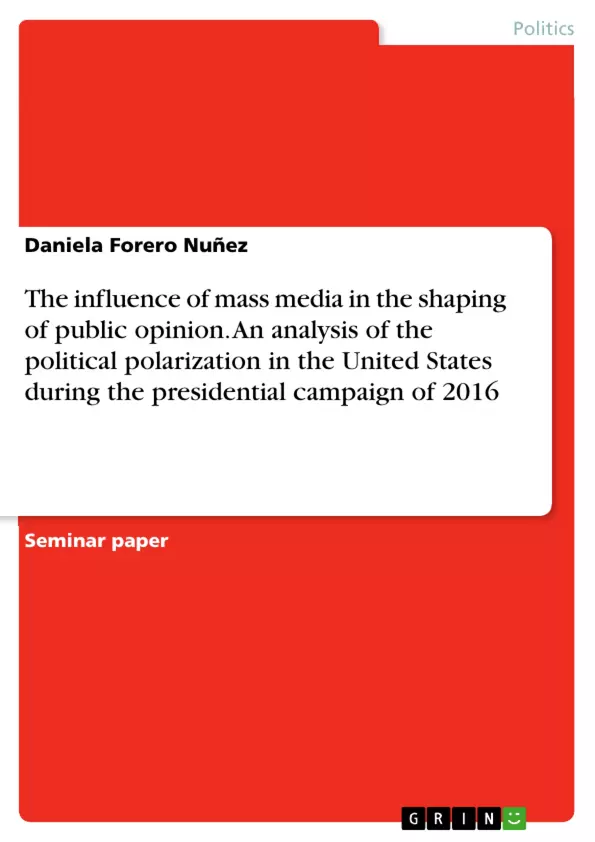This paper attempts to analyse what role the mass media played in the formation of public opinion and in the accentuation of the political polarization in the United States during the presidential campaign of 2016. The presidential elections of 2016 have definitely marked the beginning of a new political era in the United States.
But most importantly, they serve as an example of the increasing impact of mass media in political communication and in the performance of basic democratic mechanisms, such as electoral campaigning. Both Hillary Clinton’s and Donald Trump’s electoral strategies reflect the rising influence of social media and other forms of traditional media in the shaping of public opinion.
Inhaltsverzeichnis (Table of Contents)
- Introduction
- Increasing role of mass media in electoral campaigning through the mediatization of political communication
- Mass media as information resource for the electorate: Image management of the candidates through the media's news coverage
- Persuasion and advertising: targeted address of specific electoral groups
- Personification of the electoral campaigning: self-presentation of candidates and negative campaigning
- Role of mass media in the shaping of public opinion during the presidential campaign of 2016 in the United States
- Role of mass media in the news coverage and in the management of the Clinton's and Trump's public images during the electoral campaign
- Use of "big data" in social networks as important strategy of targeted advertising
- Role of the rivalry between Trump and Clinton in social networks in the building of public opinion and candidate images
- Conclusion
Zielsetzung und Themenschwerpunkte (Objectives and Key Themes)
This paper aims to analyze the role of mass media in the formation of public opinion and the intensification of political polarization in the United States during the 2016 presidential campaign. It focuses on the impact of mass media in the image-building of candidates, the news coverage, persuasive strategies, and negative campaigning.
- The influence of mass media in political communication and electoral campaigning.
- The impact of social media and traditional media on public opinion formation.
- The use of image management strategies and persuasive tactics by political candidates.
- The role of negative campaigning in the polarization of political views.
- The relationship between media coverage and the perception of political reality.
Zusammenfassung der Kapitel (Chapter Summaries)
The introduction provides an overview of the research topic and highlights the significance of the 2016 presidential election as a turning point in American political communication. It emphasizes the increasing impact of mass media in shaping public opinion and influencing electoral outcomes. The paper explores how the campaigns of both Hillary Clinton and Donald Trump reflected the growing influence of social media and traditional media.
Chapter 2 focuses on the rising role of mass media in electoral campaigning, examining the mediatization of political communication. It delves into the concept of mass media as an information source for the electorate and analyzes how the news coverage can shape the image of candidates. The chapter explores the various strategies employed by candidates to manage their public image, including persuasion and advertising techniques. It further discusses the concept of negative campaigning and its impact on electoral dynamics.
Chapter 3 investigates the influence of mass media on public opinion formation during the 2016 presidential campaign in the United States. It analyzes the role of mass media in the news coverage and the construction of public images for both Clinton and Trump. The chapter explores the use of "big data" in social networks as a tool for targeted advertising and examines the impact of the rivalry between the two candidates on the building of public opinion and candidate images.
Schlüsselwörter (Keywords)
The core themes and concepts explored in this work include political communication, mass media, electoral campaigning, public opinion formation, political polarization, image management, persuasion strategies, negative campaigning, social media, news coverage, and the 2016 United States presidential election. This paper focuses on the relationship between these keywords and their influence on the political landscape in the United States.
- Quote paper
- Daniela Forero Nuñez (Author), 2019, The influence of mass media in the shaping of public opinion. An analysis of the political polarization in the United States during the presidential campaign of 2016, Munich, GRIN Verlag, https://www.grin.com/document/1134687



